This is a guest blog post I wrote for Kristy Kroeker’s Coastal Sustainability Blog.
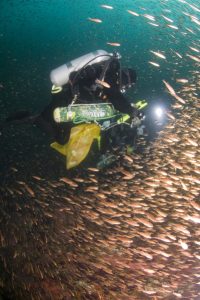
I’ve done many dives since moving to central California in 2012, but two stand out in my mind. The first was a dive in the summer of 2012, a banner year for juvenile rockfish. That day, the kelp forest was thick with baby fish that had just arrived from their time as larvae in the pelagic ocean (open ocean). The baby fish were schooling from the top of the kelp canopy to the rocky interface between the reef and the sand, and were so numerous, that one could only describe the schools as rockfish swarms. The second dive was in the fall of 2015. Central California was in the thick of “the Warm Blob” oceanographic conditions, with unseasonably warm water in Monterey Bay. I was trying to count kelp blades just below the surface of the water, but instead I spent the entire dive dodging birds diving down from above and fish darting up from below, all to feed on an enormous group of pelagic red crabs which normally live far away in the pelagic ocean off Baja. Aside from being beautiful and impressive in the sheer abundance of life I witnessed, these dives offered me a window into kelp forest food webs, and a spark of inspiration from the natural world that now motivates the first chapter of my dissertation.
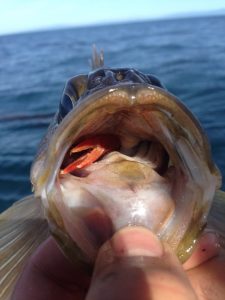
To explain my research, I want to start with food webs. We all learned about them in high school. These are the connections between all of the organisms that eat or get eaten in an ecosystem. Needless to say, in a species-rich ecosystem like a kelp forest, the food web is quite complicated. To deal with this complexity, kelp forest ecologists often think about food webs with only the set of organisms that live full-time in the kelp beds. However, my dives illustrated that there is other food available that only lives part-time in the kelp forest, and sometimes, in huge amounts! This is what scientists call a subsidy – a resource that comes into an ecosystem from another ecosystem, or from the outside. My research focuses on what these subsidies mean for kelp forest ecosystems and the animals that live within them.
My major question is simple, are these subsidies important? Or do they merely represent a “drop in the bucket” relative to all of the food produced in the kelp forest (an ecosystem more productive than trophic rainforests!)? I want to share three examples of especially visible and interesting subsidies in the Monterey Bay area to show how “ordering in” food from the outside could be extremely important for kelp forest inhabitants.
Pelagic Red Crabs
These creatures typically live in the mid-water and the bottom of the deep ocean off Baja, but during El Niño years, they show up in Monterey Bay en masse! The crabs are protein-rich and often exist in extremely high densities for short periods of time. I hypothesize that this subsidy might offset the loss of other prey items in the kelp forest during warm water, El Niño years where productivity is lower.
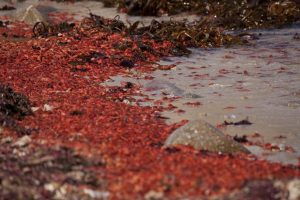
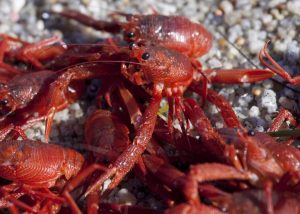
Juvenile Rockfish
First, why are rockfish considered a subsidy when they live in the kelp forest? As larvae they spend time in the open ocean, eating and growing, before bringing all of that newly gained energy from the open ocean back to the nearshore kelp beds. In some years we see very high numbers of juvenile fish, in other years, almost none. What does this major variation mean for juvenile rockfish predators such as adult rockfish (yes, they eat their babies!)? Maybe adult rockfish grow more and survive better in years when more juvenile rockfish are available as prey.
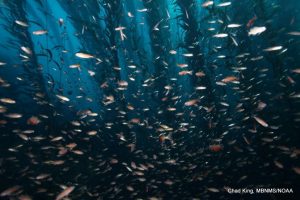
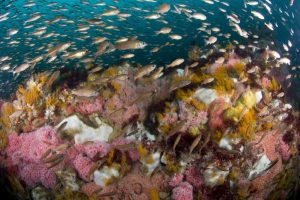
Gelatinous Organisms
These animals are ubiquitous across ecosystems, are food for everything from turtles to fishes, frequently occur in large blooms, and are vastly understudied. In Monterey Bay, currents and waves transport jellies (science name: Cnidarians), comb jellies (science name: Ctenophores) and tunicates (gelatinous organisms more closely related to humans than jellyfish!) into the kelp forest. Though these are not the most nutrient and protein-rich food items (think watermelon instead of an avocado), fish can capture and digest them using almost no energy. Perhaps gelatinous creatures make up an important, but rarely noticed component of the diverse diets of kelp forest fishes.
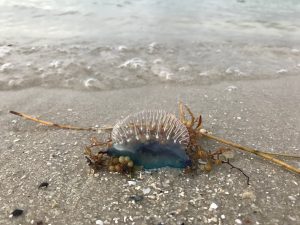
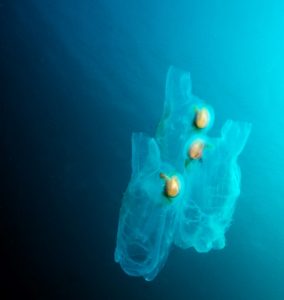
Next time you’re on the beach or in the water, keep an eye out for ecological subsidies. You might see algae washed up on the shore (a subsidy from the kelp forest to the sandy beach) or see jellies in the kelp forest from the water’s surface (a subsidy from the open ocean to the kelp forest). Subsidies like these are the norm, not the exception in our oceans, and as climate change continues to impact marine systems, the timing and magnitude of subsidies will change as well. Understanding how important (or unimportant!) these subsidies are for the ocean species we care most about will give us insight into ecosystems and food webs of the future.